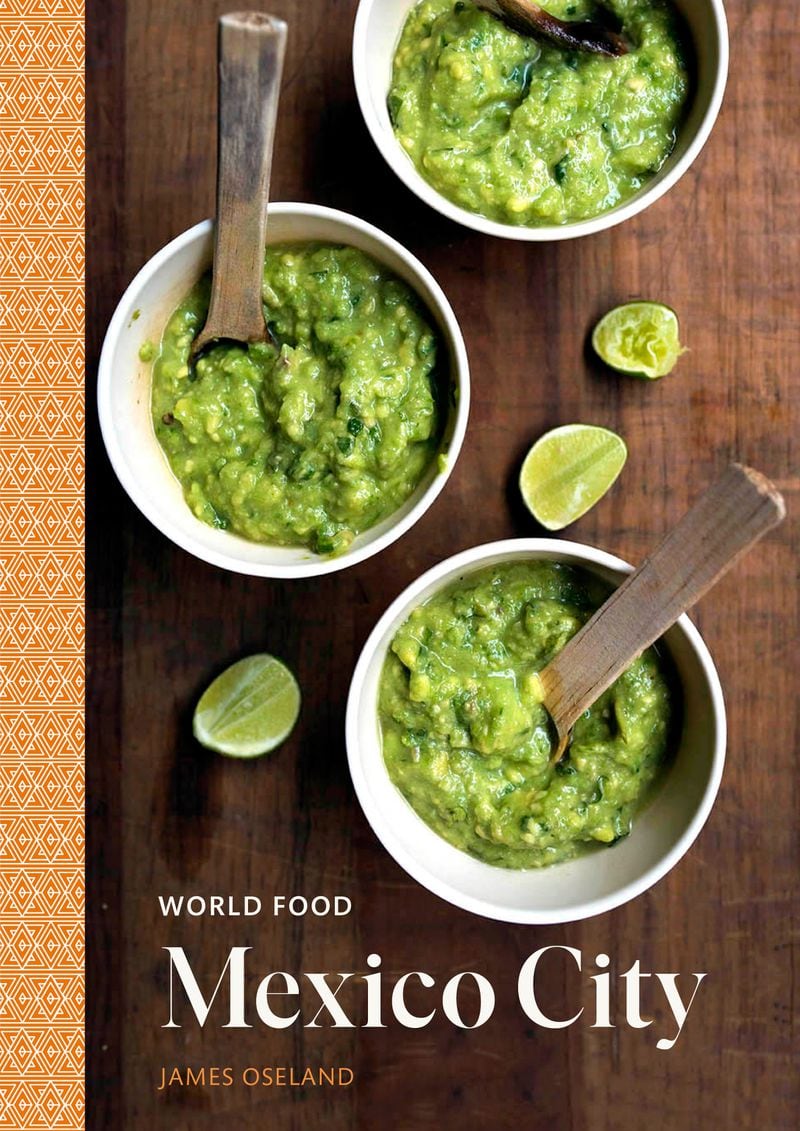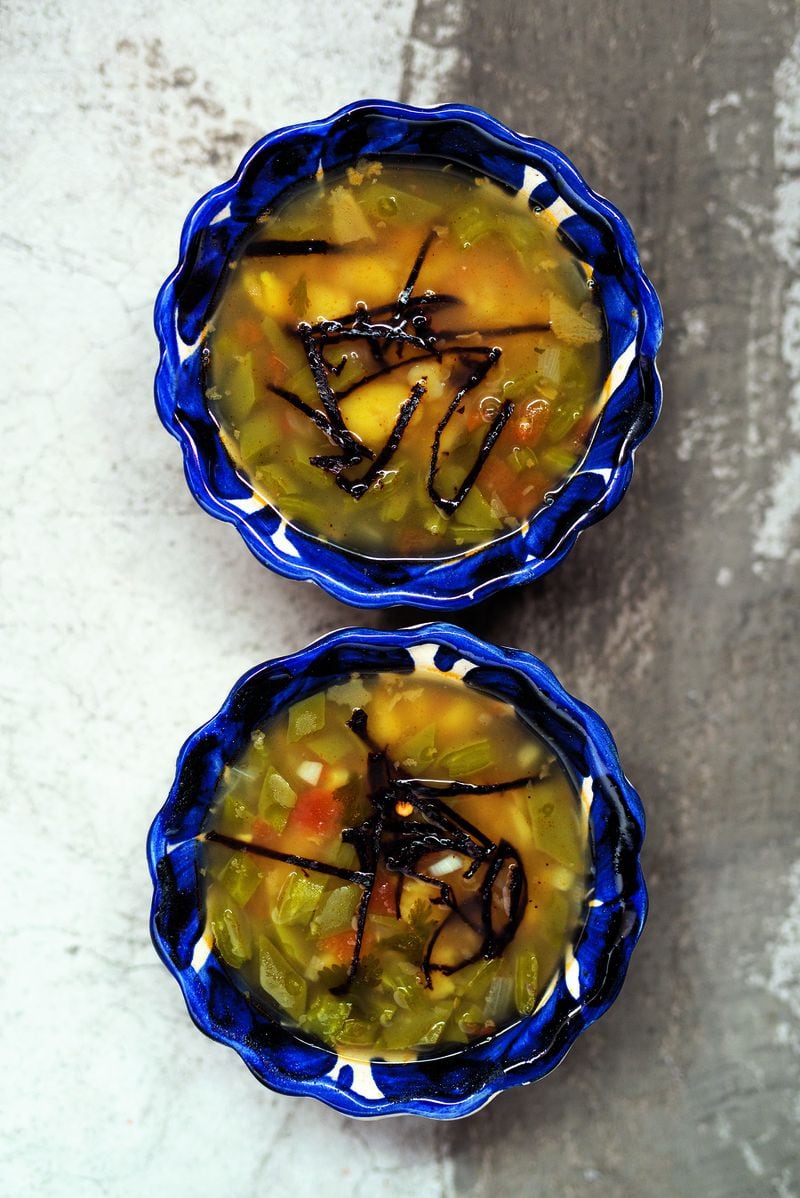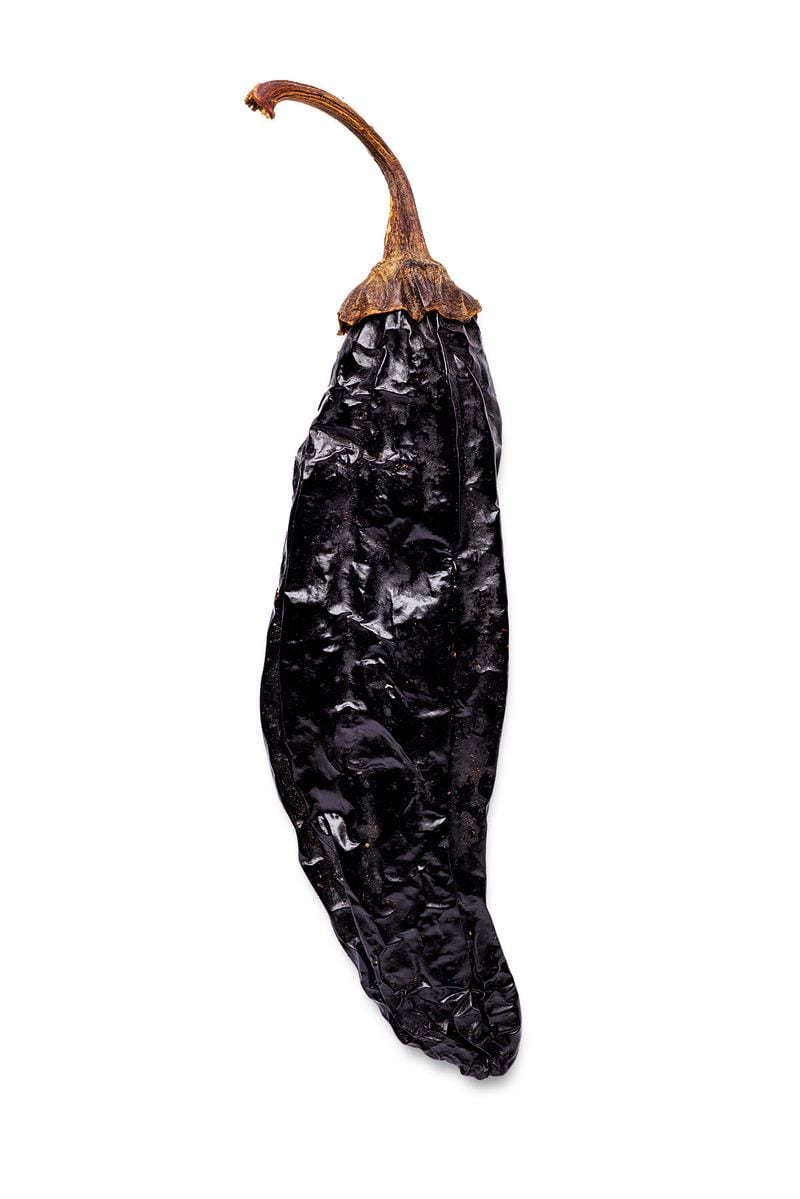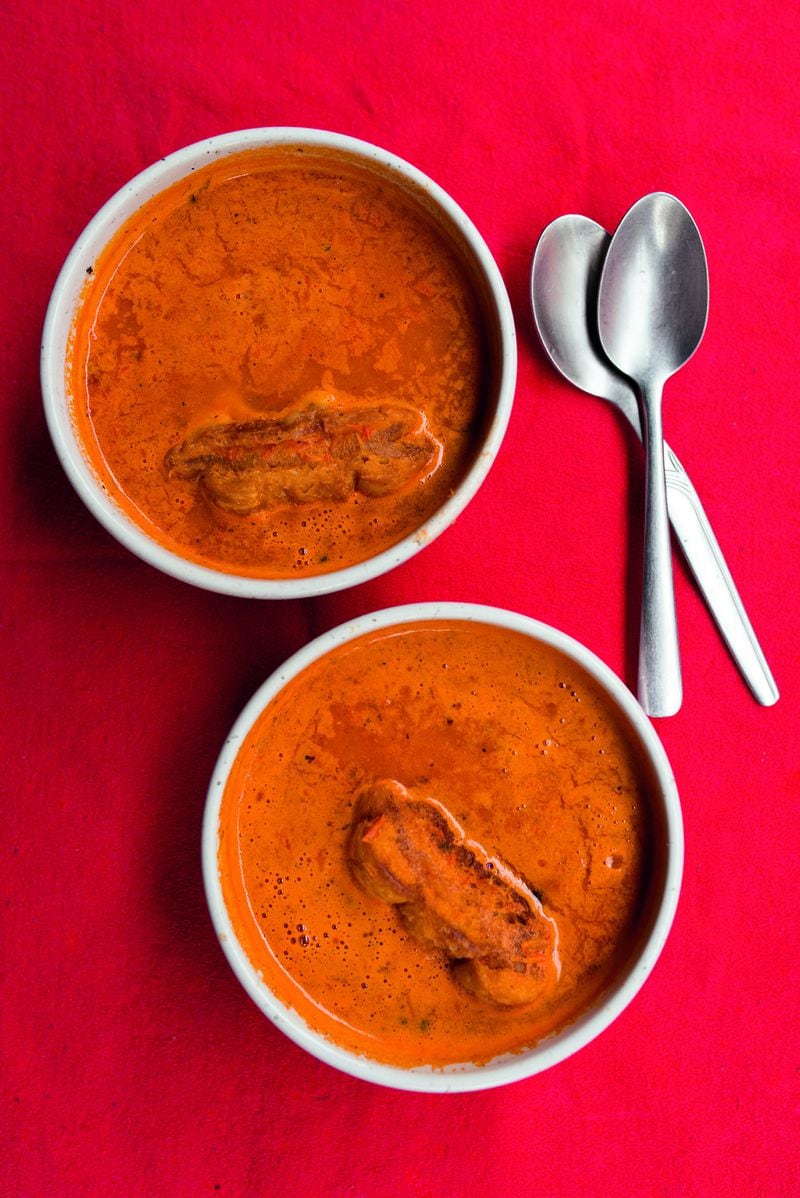How to transform a meal one spoon at a time

A waitress delivers soup from a fonda at Mexico City’s Central de Abastos market. Courtesy of Ten Speed Press/James Roper © 2020
Credit: James Roper
Credit: James Roper
Mexico City’s diners don’t simply top their soups with a shy dash of pepper, as is generally the case in the U.S. — they zest them up with a kaleidoscope of garnishes. From a plate containing toppings, I added to my soup chopped white onions, cilantro, jalapenos, and avocado. Next, I squeezed in the juice of half a small lime, and, lastly, added a dollop of house-made tomatillo salsa. I gave the soup a good stir and took a sip.
It was breathtaking, each spoonful marrying the bright-tasting garnishes with the nuanced, silky broth. Throughout the fonda, customers were also digging into their soups — so popular is this particular course that lunch is basically unthinkable without it. At the counter, a gentleman in a Stetson rolled up a hot tortilla and dipped it into his lentil soup with satisfaction.
What gives Mexican soups their soul? I pondered as I polished off my bowl.

“World Food: Mexico City: Heritage Recipes for Classic Home Cooking by” James Oseland. Courtesy of Ten Speed Press/James Roper © 2020
Credit: James Roper
Credit: James Roper
In an attempt to learn more, I invited into my kitchen Brenda Nieto and Esther Guzman, two Mexico City residents that I develop recipes with, for an afternoon of soup conjuring. Each of us would cook a different but traditional local soup.
Brenda, a young mom, wanted the task of cooking a homey variety rarely known outside its natural habitat, fava beans with cactus. In this popular soup, dried yellow fava beans, an ingredient likely introduced to Mexico City by Middle Eastern immigrants, are cooked with tomatoes, fresh mint and cactus, a staple vegetable with a tangy taste and an okra-like consistency.
“I’m always trying to get my 5-year-old to eat her vegetables — and cactus is definitely not one of her favorites,” Brenda said with a laugh. “Maybe if I replace it with green beans, I’ll make some progress.”
The results, the three of us concurred, were excellent — Brenda promised she’d let us know later if her daughter approved. Beyond that, we loved the substitution of the green beans, and the fava beans had a comforting, split pea-like consistency with a marvelously earthy flavor.
Meanwhile, Esther, a woman in her 40s who lives with her extended family, went about sauteing in olive oil a head and a half’s worth of rough-chopped garlic as the first step in making garlic soup, her chosen dish. The tantalizing aroma of the garlic as it transformed from raw and sharp to sweet and golden filled the kitchen. As Esther blended the cooked garlic with the other ingredients — including chicken broth and paprika — she commented on how easy it was to make.
“For such a simple process,” she said, “you really get complex flavor.”
We sampled the finished soup, its glossy surface now elegantly garnished with a manchego-and-baguette crouton, and decided that it was the perfect repast for a chilly afternoon. Sure, the garnish was arguably a case of gilding the lily — but why the heck not, we all agreed.
My challenge that day was to concoct caldo de pollo, Mexico City’s answer to chicken in a pot. Like Esther’s soup, this one couldn’t have been easier to prepare. I placed into a stockpot nearly all the ingredients: chicken cut into serving pieces, water, white onion, garlic cloves, bay leaves, whole allspice berries, and cilantro and mint sprigs.
What I began to understand as the dish burbled along for the next hour or so was that patience was key. I sniffed and stirred it frequently, marveling as the broth matured and grew increasingly aromatic. After the chicken was nearly cooked, I added a few handfuls of carrots and chayotes cut into rustic pieces.
Later, after all the requisite garnishes were added to our bowls, the three of us tried the soup. With all due respect to Señora Norma and her fine rendition of it, the soup was every bit as magical and satisfying.
James Oseland is the author and editor of “World Food: Mexico City,” part of a new book series from Ten Speed Press. For more information, visit jamesoseland.com; follow @jamesoseland on Instagram.
RECIPES
Mexico City’s diners don’t simply top their soups with a shy dash of pepper, as is generally the case in the U.S. — they zest them up with a kaleidoscope of garnishes.

For Fava Bean and Nopales Soup, you can use nopales (cactus paddle) or green beans. Courtesy of Ten Speed Press/James Roper © 2020
Credit: James Roper
Credit: James Roper
Fava Bean and Nopales Soup
In this comforting soup, mint, a traditional Mexican companion to fava beans, adds herbal nuance. If you can’t find fresh nopales (cactus paddle), coarsely chopped green beans can be substituted. A recipe for a traditional pasilla chile garnish follows the main recipe.
Fava Bean and Nopales Soup
- 2 tablespoons canola oil
- 1/2 medium white onion, finely chopped
- 2 Roma tomatoes, finely chopped
- 2 cups dried peeled yellow fava beans, rinsed
- 2 spearmint or peppermint sprigs, including stems
- 9 cups water
- 2 cups cleaned nopales, cut into 1/2-inch squares, or stemmed green beans, cut into 1/2-inch pieces
- 5 cilantro sprigs, including stems
- 2 teaspoons salt
- Pasilla Chile Garnish (optional) (recipe follows)
- In a medium saucepan, heat the oil over medium heat. When the oil is hot, add the onion and cook, stirring constantly, until translucent and just turning golden, about 4 minutes. Add the tomatoes and cook, stirring often, until wilted. Add the fava beans, mint, and water and bring to a boil, skimming off any foam that forms. Turn down the heat to medium, cover partially, and cook, stirring occasionally, until the beans are beginning to fall apart, 1 1/2 to 2 hours. If the water level falls to expose the tops of the beans, add more boiling water, 1/2 cup at a time, as needed to cover. When the favas are ready, remove from the heat and, using the back of a large spoon, mash the beans until somewhat smooth.
- Add to the soup the nopales or green beans, cilantro, and 2 teaspoons salt and stir to mix. The mixture should be the consistency of soup. If it’s too dry, add water, 1/2 cup at a time. Mix well, then taste for salt, adding more if needed. Simmer gently for 30 minutes. Serve immediately in soup bowls with the pasilla chile garnish, if desired.
Serves 4.
Nutritional information
Per serving: Per serving (without pasilla chile garnish): 343 calories (percent of calories from fat, 20), 21 grams protein, 50 grams carbohydrates, 18 grams fiber, 8 grams total fat (1 gram saturated), no cholesterol, 775 milligrams sodium.

A pasilla chile can become a crunchy garnish. Courtesy of Ten Speed Press/James Roper © 2020
Credit: James Roper
Credit: James Roper
Pasilla Chile Garnish
Pasilla chiles are earthy-tasting, faintly piquant dried Mexican chiles about the length of your hand. Lightly pan-frying pasillas transforms them into a delightful, crunchy garnish; the whole, fried chiles are often placed on a plate at the center of the table so diners can tear a few pieces and add them directly to their soup (or other dishes, like scrambled eggs). To make them, line a plate with a paper towel. Heat a skillet over medium heat. When the pan is hot, add 3 tablespoons canola oil. When the oil is hot, add 2 to 4 chiles and fry on all sides until they are slightly puffy and about 2 shades darker, about 3 minutes total. Transfer to the lined plate. Invite diners to break the whole chiles, seeds and all, into small pieces directly into their soup. Leftovers can be stored in a plastic container for a week.

Cantina-Style Garlic Soup isn’t complicated to make yet it offers complex flavor. Courtesy of Ten Speed Press/James Roper © 2020
Credit: James Roper
Credit: James Roper
Cantina-Style Garlic Soup
This zesty and comforting soup, perfect for a chilly afternoon, is a Mexico City cantina classic for good reason: It pairs well with beer, tequila, mezcal or a tannic white wine.
Cantina-Style Garlic Soup
- 5 tablespoons olive oil, divided
- About 1 1/2 heads garlic (20 to 25 cloves), separated into cloves, peeled, and very coarsely chopped
- 1 medium Roma tomato, coarsely chopped
- 2 cilantro sprigs, including stems
- 1 1/2 teaspoons sweet paprika
- 4 cups chicken broth, divided
- Salt
- 4 baguette slices, each 1/3-inch thick
- 4 thin slices manchego, Monterey Jack or other good melting cheese
- In a skillet, heat 3 tablespoons of the oil over low heat. Add the garlic, cover, and cook, stirring often, until golden and softened, about 15 minutes (don’t let the garlic brown, which will result in a bitter-tasting soup). Raise the heat slightly and add the tomato, cilantro and paprika, and cook, stirring often, until the tomato just begins to soften, about 3 minutes. Remove from the heat, pour into a blender, add 1 cup of the broth, and blend until smooth.
- Pour the blended broth mixture into a medium saucepan and add the remaining 3 cups broth. Taste for salt, adding more if needed. Bring to a simmer and cook on low heat for 10 minutes.
- Wipe out the skillet, place over medium heat, and add the remaining 2 tablespoons oil. When the oil is hot, add the baguette slices and fry both sides until golden, 2 to 3 minutes total. Top each baguette slice with a cheese slice, flip them cheese-side down, and cook until the cheese is melted and golden, about 1 minute.
- Ladle the soup into individual bowls and top each serving with a cheese crouton. Serve immediately.
Serves 4.
Nutritional information
Per serving: Per serving: 374 calories (percent of calories from fat, 66), 12 grams protein, 20 grams carbohydrates, 1 gram fiber, 28 grams total fat (8 grams saturated), 31 milligrams cholesterol, 913 milligrams sodium.

A young woman holds caldo de pollo, Mexico City’s answer to chicken in a pot. Courtesy of Ten Speed Press/James Roper © 2020
Credit: James Roper
Credit: James Roper
Mexican-Style Chicken and Vegetable Soup
A homey weeknight classic that gets its verve from whole allspice and cilantro and mint sprigs. The garnishes that appear after the main recipe aren’t essential but will result in a dish that tastes truly Mexican; the garnishes can be mixed and matched as desired.
Mexican-Style Chicken and Vegetable Soup
- 2 1/2 pounds bone-in, skin-on chicken parts (preferably thighs and drumsticks)
- 1 medium white onion, quartered
- 5 garlic cloves
- 2 teaspoons salt
- 2 bay leaves
- 3 whole allspice berries
- 4 cilantro sprigs
- 4 mint sprigs
- 3 medium carrots, cut into thin coins
- 2 medium chayotes cut into 2-inch-thick chunks
- In a large pot, combine the chicken, onion, garlic, salt, bay leaves, allspice, cilantro and mint. Add cold water to cover by about 1 inch (about 7 cups), stir well, and bring to a boil. Turn down the heat to medium-low; you want to maintain a good, steady simmer for the duration of the cooking. Skim off and discard any foam that forms. Cook, uncovered, at a steady simmer, stirring occasionally and periodically skimming off the fat if desired, until the chicken is half cooked, about 45 minutes.
- Add the carrots and chayotes and cook until the vegetables are tender and the chicken is cooked through, about 45 minutes more. Remove from the heat, then taste for salt and add more if needed. Serve immediately with the garnishes.
Serves 4.
Nutritional information
Per serving: Per serving: 421 calories (percent of calories from fat, 62), 27 grams protein, 13 grams carbohydrates, 4 grams fiber, 29 grams total fat (8 grams saturated), 101 milligrams cholesterol, 896 milligrams sodium.
Traditional Garnishes
Serve this soup with the following garnishes, which can be placed in individual bowls on your serving table, if desired: 1 cup minced white onion; 1/2 cup minced stemmed jalapenos (unseeded if you crave chile heat); 1 cup minced cilantro leaves and stems; 1 cup coarsely chopped avocado; fresh-made salsa to your liking; a few halved limes for squeezing on top.
Read more stories like this by liking Atlanta Restaurant Scene on Facebook, following @ATLDiningNews on Twitter and @ajcdining on Instagram.
